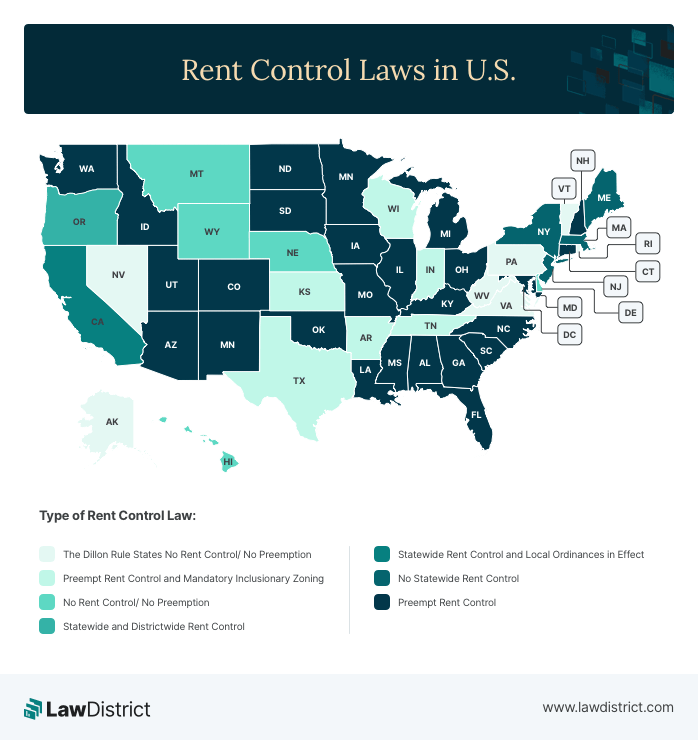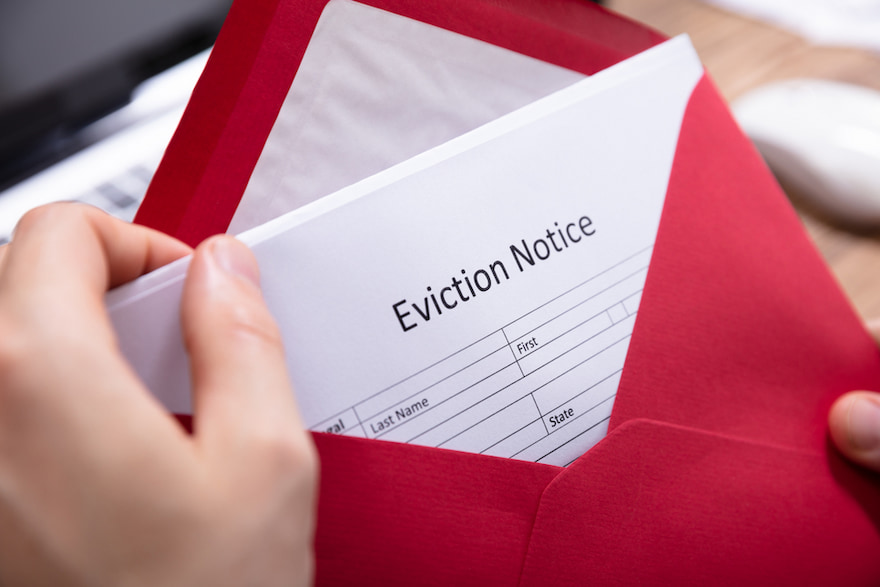
As a tenant, it’s essential to know your state’s laws before signing an agreement with a landlord or paying any fees that may be illegal.
The last two years have seen rent charges hit the ceiling. Shockingly, some states have seen rent increases of 30% or more. RedFin's analysis found that in December 2021, the US rent increased 14% to $1,877 per month, the most significant increase over two years.
Among the most affected cities were Austin, Texas, with a 40% rise in rental prices; New York City, with a 35% rise; and several metros in Florida, with over 30% increases. Currently, there are fewer housing options for rent or sale than 30 years ago, resulting in rising rental costs and inflation and making home ownership increasingly impractical.
However, laws are in place that make it so that landlords cannot charge any amount of money for rent.
The laws vary depending on the state and municipality, and rent-control laws may be enacted by the federal government, states, or local governments, keep reading to understand limitations in your area.
What is the Federal Rent Control Law?
Originally, rent control was part of a federal law enacted after World War II to deal with the housing shortage. Nowadays, most locales no longer require emergencies to implement rent-control laws. The rules have been challenged repeatedly in court, but if they protect property owners, they can be upheld.
To assist low-income families and people with disabilities, the Federal Department of Urban Development (HUD) offers the Housing Choice Voucher Program (Section 8 housing). In the private market, they find safe and affordable housing, and families who qualify receive housing choice vouchers from their local public housing agency.
The PHAs determine whether a family is eligible for Section 8 housing based on income and size. Section 8 qualifications require a family's income to be below 50% of the median income in their area, but this varies by city and state.
Landlords can participate or not, and housing authorities will provide subsidies directly to landlords, and tenants pay the difference.
How State and Local Rent Control Laws Work
As of February 2022, 31 states prohibit or preempt local governments from enacting rent control measures. Cities and counties pass rent control ordinances administered by local rent control boards.
Being large cities, New York and San Francisco have robust rent control laws. If a landlord wants to send a lease termination letter or a rent increase letter, they may need permission from the rent control board.
What is a Rent Increase Letter?
A rent increase letter informs you as a tenant, that your rent is about to rise. Before raising the rent, there are specific rules and procedures that landlords need to follow, and a landlord may wish to consult with a property manager or real estate attorney.
Landlords must wait for a lease agreement to expire before increasing rent, unless the lease allows it. However, a landlord cannot raise the rent if the rental property is in a city or state with rent control laws.
Some landlord-tenant laws require landlords to give you at least 30 days' notice before raising the rent on a month-to-month lease, depending on the area.
Read more:How to Write a Landlord-Friendly Rent Increase Letter
Rent Control in the District of Columbia
The Rental Housing Act of 1985 established rent control in the District of Columbia and is relatively aggressive. A landlord must follow several rules when raising the rent on a unit covered by the Act.
According to these rules:
- An annual rent increase is the only option.
- Most rent increases are limited to 2% plus the Consumer Price Index increase.
- Rent increases cannot exceed 5% per year for elderly and disabled tenants.
All rental units are protected from eviction under the rent stabilization portion of this Act.
Rent Control in New York City
The city of New York and certain other counties have a rent control system in place. The control applies only to residential properties built before February 1947, in which tenants or lawful successors have resided continuously since July 1, 1971.
This rent control assigns maximum base rent to each property. In order to reflect changes in operating costs, the base rent is adjusted once every two years. The property becomes either rent-stabilized or unregulated when a tenant or successor moves out.
Rent Control in Oregon
In 2019, Oregon was the first state to impose statewide rent control. Rent increases are limited to 7% plus inflation within 12 months under this law, which is calculated every September by state economists. Rents subsidized by the government or buildings older than 15 years are not subject to this policy.
Rent Control in New Jersey
Over 100 cities and townships have passed rent control ordinances in New Jersey. Your local city or township hall can provide you with more information on each.
Rent Control in Maryland
Several counties and cities in Maryland have adopted rent control laws. Among the affordable housing communities in Washington/Baltimore, Takoma Park limits rent increases to one per year, which is equal to the Consumer Price Index for the region.
Takoma Park enforces rent regulation through rent stabilization, and the allowances are published annually by the city in late spring.
Rent Control in California
As of January 1, 2021, California Governor Newsom had approved a statewide rent control law. In most cases, a typical rent increase is restricted to 5%, plus inflation, as determined by the Consumer Price Index.
This law, however, also gives local jurisdictions the power to adopt stricter rent control laws. For this reason, rent control is prevalent in many areas.
Rent Control Laws by State
To help you see what kinds of laws are applicable in each state, the following table has the type of law and which states fall into said category.

Some states are known as Dillon Rule states, which comes from Judge John Forrest Dillon in Clinton v. Cedar Rapids and the Missouri River Railroad (1868). This Dillon Rule limits local governments to legislating what the state government has decreed. Municipalities may approach the state if they wish to exercise authority beyond that delegated to them.
| Type of Rent Control Law | States Included |
|---|---|
| The Dillon Rule States No Rent Control/ No Preemption | West Virginia, Alaska, Nevada, Pennsylvania, Vermont, Virginia, Rhode Island |
| States That Preempt Rent Control
and Mandatory Inclusionary Zoning |
Arizona, Indiana, Kansas, Tennessee, Texas, |
| States With No Rent Control/ No Preemption | Hawaii, Nebraska, Montana, Wyoming, Delaware |
| States and Federal Districts with Statewide and Districtwide Rent Control | District of Columbia, Oregon |
| States With Statewide Rent Control
and Local Ordinances in Effect |
California |
| States With No Statewide Rent Control; County and City Laws in Effect. | New York, Maine, New Jersey, Maryland |
| States That Preempt Rent Control | Maine, Maryland, New Jersey, New York, Alabama, Arkansas, Colorado, Connecticut, Florida, Georgia, Idaho, Illinois, Iowa, Kentucky, Louisiana, Massachusetts, Michigan, Minnesota, Mississippi, Missouri, New Hampshire, New Mexico, North Carolina, North Dakota, Ohio, Oklahoma, South Carolina, South Dakota, Utah, Washington |
For a landlord or a tenant with legal issues related to rent control laws, carefully interview a potential real estate attorney to ensure they are thoroughly familiar with your particular rent-control scheme.
Be sure they review the sales contracts and residential lease agreements to confirm all applicable rent control laws before trying to increase your rent.
Start your Rent Increase Letter Here
Helpful Resources:
New York Office of Rent Administration - Rent Stabilization and Rent Control
As a tenant, it’s essential to know your state’s laws before signing an agreement with a landlord or paying any fees that may be illegal.
The last two years have seen rent charges hit the ceiling. Shockingly, some states have seen rent increases of 30% or more. RedFin's analysis found that in December 2021, the US rent increased 14% to $1,877 per month, the most significant increase over two years.
Among the most affected cities were Austin, Texas, with a 40% rise in rental prices; New York City, with a 35% rise; and several metros in Florida, with over 30% increases. Currently, there are fewer housing options for rent or sale than 30 years ago, resulting in rising rental costs and inflation and making home ownership increasingly impractical.
However, laws are in place that make it so that landlords cannot charge any amount of money for rent.
The laws vary depending on the state and municipality, and rent-control laws may be enacted by the federal government, states, or local governments, keep reading to understand limitations in your area.
What is the Federal Rent Control Law?
Originally, rent control was part of a federal law enacted after World War II to deal with the housing shortage. Nowadays, most locales no longer require emergencies to implement rent-control laws. The rules have been challenged repeatedly in court, but if they protect property owners, they can be upheld.
To assist low-income families and people with disabilities, the Federal Department of Urban Development (HUD) offers the Housing Choice Voucher Program (Section 8 housing). In the private market, they find safe and affordable housing, and families who qualify receive housing choice vouchers from their local public housing agency.
The PHAs determine whether a family is eligible for Section 8 housing based on income and size. Section 8 qualifications require a family's income to be below 50% of the median income in their area, but this varies by city and state.
Landlords can participate or not, and housing authorities will provide subsidies directly to landlords, and tenants pay the difference.
How State and Local Rent Control Laws Work
As of February 2022, 31 states prohibit or preempt local governments from enacting rent control measures. Cities and counties pass rent control ordinances administered by local rent control boards.
Being large cities, New York and San Francisco have robust rent control laws. If a landlord wants to send a lease termination letter or a rent increase letter, they may need permission from the rent control board.
What is a Rent Increase Letter?
A rent increase letter informs you as a tenant, that your rent is about to rise. Before raising the rent, there are specific rules and procedures that landlords need to follow, and a landlord may wish to consult with a property manager or real estate attorney.
Landlords must wait for a lease agreement to expire before increasing rent, unless the lease allows it. However, a landlord cannot raise the rent if the rental property is in a city or state with rent control laws.
Some landlord-tenant laws require landlords to give you at least 30 days' notice before raising the rent on a month-to-month lease, depending on the area.
Read more:How to Write a Landlord-Friendly Rent Increase Letter
Rent Control in the District of Columbia
The Rental Housing Act of 1985 established rent control in the District of Columbia and is relatively aggressive. A landlord must follow several rules when raising the rent on a unit covered by the Act.
According to these rules:
- An annual rent increase is the only option.
- Most rent increases are limited to 2% plus the Consumer Price Index increase.
- Rent increases cannot exceed 5% per year for elderly and disabled tenants.
All rental units are protected from eviction under the rent stabilization portion of this Act.
Rent Control in New York City
The city of New York and certain other counties have a rent control system in place. The control applies only to residential properties built before February 1947, in which tenants or lawful successors have resided continuously since July 1, 1971.
This rent control assigns maximum base rent to each property. In order to reflect changes in operating costs, the base rent is adjusted once every two years. The property becomes either rent-stabilized or unregulated when a tenant or successor moves out.
Rent Control in Oregon
In 2019, Oregon was the first state to impose statewide rent control. Rent increases are limited to 7% plus inflation within 12 months under this law, which is calculated every September by state economists. Rents subsidized by the government or buildings older than 15 years are not subject to this policy.
Rent Control in New Jersey
Over 100 cities and townships have passed rent control ordinances in New Jersey. Your local city or township hall can provide you with more information on each.
Rent Control in Maryland
Several counties and cities in Maryland have adopted rent control laws. Among the affordable housing communities in Washington/Baltimore, Takoma Park limits rent increases to one per year, which is equal to the Consumer Price Index for the region.
Takoma Park enforces rent regulation through rent stabilization, and the allowances are published annually by the city in late spring.
Rent Control in California
As of January 1, 2021, California Governor Newsom had approved a statewide rent control law. In most cases, a typical rent increase is restricted to 5%, plus inflation, as determined by the Consumer Price Index.
This law, however, also gives local jurisdictions the power to adopt stricter rent control laws. For this reason, rent control is prevalent in many areas.
Rent Control Laws by State
To help you see what kinds of laws are applicable in each state, the following table has the type of law and which states fall into said category.

Some states are known as Dillon Rule states, which comes from Judge John Forrest Dillon in Clinton v. Cedar Rapids and the Missouri River Railroad (1868). This Dillon Rule limits local governments to legislating what the state government has decreed. Municipalities may approach the state if they wish to exercise authority beyond that delegated to them.
| Type of Rent Control Law | States Included |
|---|---|
| The Dillon Rule States No Rent Control/ No Preemption | West Virginia, Alaska, Nevada, Pennsylvania, Vermont, Virginia, Rhode Island |
| States That Preempt Rent Control
and Mandatory Inclusionary Zoning |
Arizona, Indiana, Kansas, Tennessee, Texas, |
| States With No Rent Control/ No Preemption | Hawaii, Nebraska, Montana, Wyoming, Delaware |
| States and Federal Districts with Statewide and Districtwide Rent Control | District of Columbia, Oregon |
| States With Statewide Rent Control
and Local Ordinances in Effect |
California |
| States With No Statewide Rent Control; County and City Laws in Effect. | New York, Maine, New Jersey, Maryland |
| States That Preempt Rent Control | Maine, Maryland, New Jersey, New York, Alabama, Arkansas, Colorado, Connecticut, Florida, Georgia, Idaho, Illinois, Iowa, Kentucky, Louisiana, Massachusetts, Michigan, Minnesota, Mississippi, Missouri, New Hampshire, New Mexico, North Carolina, North Dakota, Ohio, Oklahoma, South Carolina, South Dakota, Utah, Washington |
For a landlord or a tenant with legal issues related to rent control laws, carefully interview a potential real estate attorney to ensure they are thoroughly familiar with your particular rent-control scheme.
Be sure they review the sales contracts and residential lease agreements to confirm all applicable rent control laws before trying to increase your rent.
Start your Rent Increase Letter Here
Helpful Resources:
New York Office of Rent Administration - Rent Stabilization and Rent Control
Most Popular Posts

If your minor child travels alone in the United States, you will most likely be required to complete documentation through the airline's...

An eviction filed by your landlord hurts your credit report. It is also held as a public record and other landlords can view your previous rental...